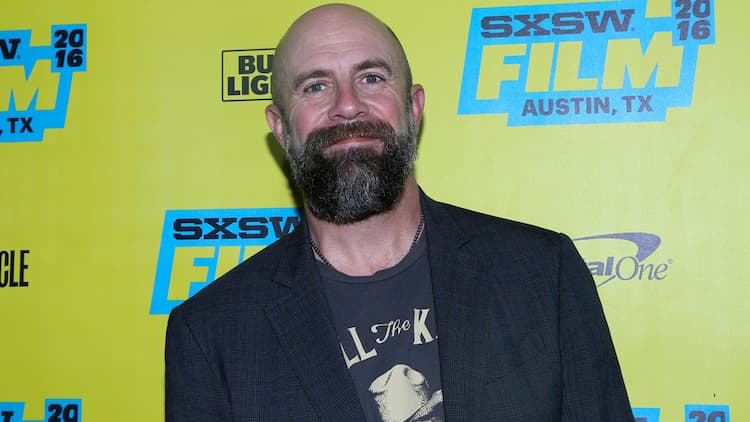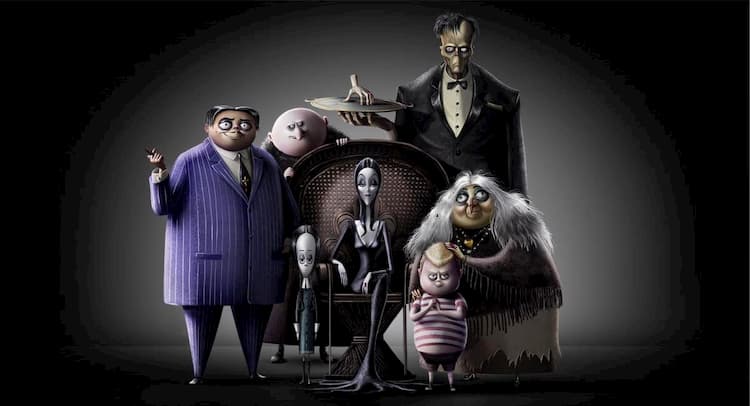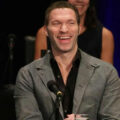Conrad Vernon Biography
Conrad Vernon is a voice actor, director, writer and storyboard artist from the United States. He is best known for his work on the DreamWorks animated film series Shrek.
Additionally, he has as well worked on other films such as Monsters vs. Aliens, Madagascar 3: Europe’s Most Wanted and Penguins of Madagascar. He was a co-director in the adult animated film, Sausage Party. Sausage Party is a spoof of his notable works in DreamWorks.
Conrad Vernon Age
He was born on the 11th of July in 1968. He was 50 years old as of 2018.
Conrad Vernon Career
He studied at CalArts. He was a storyboard artist on Cool World, 2 Stupid Dogs, Rocko’s Modern Life, Nightmare Ned, Squirrel Boy, and Morto the Magician.
He joined DreamWorks in 1996. There, he worked as a storyboard artist on Antz. Following the success of Antz as the first animated feature film to be produced by DreamWorks Animation, he signed on as a writer for Shrek. In the movie Shrek, he was responsible for the Gingerbread Man, and eventually voiced that character. Additionally, he appeared in Shrek 4-D and Sinbad: Legend of the Seven Seas.
In June of 2004, he made his feature film directorial debut, with Shrek 2. He is the voice behind Mason the chimpanzee in the DreamWorks Animation films Madagascar, Madagascar: Escape 2 Africa, Madagascar 3: Europe’s Most Wanted. He is credited as the director of Madagascar 3: Europe’s Most Wanted. In Madagascar spin-off, Penguins of Madagascar, he voiced Rico, one of the penguins. In addition, he reprised the voice of Mason in the TV series.
He co-directed, alongside Rob Letterman, the 3D animated film Monsters vs. Aliens. He was a co-writer in the film in addition to supplying several voices.
He co-directed, alongside Greg Tiernan, the adult animated comedy Sausage Party. The film’s story was from Seth Rogen, Evan Goldberg, and Jonah Hill. Additionally, he provided some of the voices. He, in addition, co-produced and co-directed, again with Greg Tiernan, an animated version of The Addams Family. The movie is set to be released around the end of 2019.

Conrad Vernon The Addams Family
The Addams Family is an upcoming 3D computer-animated comedy film from the United States. The movie is based on The Addams Family comics by Charles Addams. Conrad Vernon and Greg Tiernan, previously the directors of Sausage Party, are the directors of the film. The film will feature the voices of Oscar Isaac, Charlize Theron, Chloë Grace Moretz, Finn Wolfhard, Nick Kroll, Bette Midler, and Allison Janney. On the 11th of October in 2019, the film is set to be released by Metro-Goldwyn-Mayer.

Conrad Vernon Sausage Party Interview
Congratulation on Sausage Party. I think a lot of people in the feature animation industry will be rooting for it because we need more films like this and this is a great example of what animation can be and where it can go…
Conrad Vernon: Greg and I always like to say, for a long time animation has been seen as a family/kids’ medium—even genre—because that’s pretty much the only films that are made in animation today. And the reason it was really important for us to make this movie is that we wanted to tear down that wall for telling different types of stories, and bringing different genres into the art form of animation. When we were pitching this, we had Seth [Rogen] and Jonah [Hill] promising to star in it, I was going to direct it, we had Greg’s studio and he was going to co-direct with me, we had a script written by Seth, Evan [Goldberg], Kyle [Hunter], and Ariel [Shaffir]. That was a pretty damn good package along with all the artwork, and people still didn’t understand what we were going for because it had never been done, which is kind of amazing to me. Most live-action studios were saying we don’t understand animation so we don’t want to get involved, and most of the animation companies were like, we have a brand name and we’re not ruining it with this movie. So we were kind of stuck between a rock and a hard place, but thanks to [Megan Ellison’s] Annapurna and Columbia/Sony, I hope that we have opened a door and proven that there is an audience and a viable market for this type of animation—that people of all ages love animation, so filmmakers should be able to make all kinds of animation for different audiences.
How many other studios did you pitch it to before Annapurna and Sony got involved?
Conrad Vernon: Oh, dozens. We went to big ones, small ones; we even started talking about maybe private investors. We wanted to get this done really bad, and I can promise you if we hadn’t sold it to Annapurna and Columbia, Seth, Evan, Greg, and I would still be out there pitching this movie, trying to get it made.
Conrad, you directed for a long time at Dreamworks, where the films have higher budgets and you have more resources at your disposal. What adjustments did you have to make to direct a film that’s a fraction of the cost of a typical Dreamworks film?
Conrad Vernon: Greg and I approached it as we would approach anything else. I’d done three films at Dreamworks so I kind of knew what kind of a production line I wanted to [use], and Greg had a very similar production line, so we were on the same page there. And instead of trying to simplify this movie so that we can fit within this budget, we just said let’s make a beautiful, great-looking, well-animated, cinematic film, and see where we have to pull back. I’d rather go too far and have to pull back a little bit than not go far enough and say, “Wow, we came in under budget. It’s too bad we couldn’t make the film look better.” So Greg and I creatively approached it like we would approach any other movie.
There’s something that I’ve been wanting to do since the day I started at Dreamworks that we got to do on this film, which took our characters and make them very appealing, but very simple design-wise. Craig Kellman did a brilliant job helping us out on that. Then, when we rigged them, we had the animators actually go in and take shots from old Bob Clampett cartoons, and Popeyes and Chuck Jones stuff, and literally rotoscope our character over it to make sure that they could do all the crazy stuff that those old cartoons did, so that we could get a really good, loose 2D-animated feel to these characters. We used multi-arms, wipes, dry brush effects—we did all that stuff, and it helped give a unique style, but it also wasn’t horribly expensive to do.
At Dreamworks, you answered creatively to Jeffrey Katzenberg. Who did you answer to creatively on this film?
Conrad Vernon: Well, Greg and I first, and then Seth and Evan. But it was nice because they worked as partners with us. They were in charge of the script, and we were all in charge of recording the actors, and [Greg and I] were in charge of the animation. We always sat down with them every week, like on a Friday or something, and ran them through all the designs, all the character stuff, all the animation, the effects, everything, so that they had an input, but 95% of the time, they’d look at it and just go, “Beautiful. We love it.” As far as the studio was concerned, they were really, really supportive and pretty hands-off. We only had, I think, two or three screenings for them, and they came in with some really great notes. We went through them, saw the ones that were really helpful and would get us to the next level, and then we moved on. Sony and Annapurna were nothing but supportive, and said, “You guys are the creators; you’re in charge of this. Go and make your movie and we’ll be here to help whatever way we can.”
What you’re describing is very different from a lot of times when live-action people become involved in animation. When we spoke to Genndy Tartakovsky about making Hotel Transylvania 2, he was vocal about how Adam Sandler wanted to take control of the film, which can be problematic when someone doesn’t fully understand the process. Did you run into such difficulties or was it a smooth process?
Conrad Vernon: I can say, looking back, that it was a smooth process. Yes, they didn’t understand the animation process. That’s why they brought me in, and they pretty much just said, “Take care of that. Just keep us in the loop and keep us involved with what you’re doing and explain it.” Now, there were a lot of changes that we needed to make—there were some changes that we made after something was animated, there were a couple of lines changed after something was lit.
Basically, it came down to a very simple act of sitting down and talking about whether or not the film was going to be better for it. Greg and Nicole [Stinn] at Nitrogen were really supportive of saying we’re going to try and push this through the pipeline; Annapurna was really supportive of saying they’ll kick in a few extra bucks to make it happen. And that’s all it really was—it was just making sure that that collaboration existed and that the communication was really clear. We’d all sit down [and talk]: This is going to cost this much money, it’s going to take this much time. Can we do it and is it worth it? Sometimes it was and sometimes it wasn’t. But there was never any acrimony that went along with it. There was some stress to be sure, but there were no creative disputes over it.
One of the things I really appreciate about the film is the duality of the characters. When they’re amongst themselves they have eyes and mouths, and when the humans are looking at them, they’re just inanimate objects. The concept was communicated very well cinematically, and I wanted to know more about who came up with the idea: was that in the script or was it something you came up with during the process of developing the film?
Conrad Vernon: We were really cognizant about how we were going to show that change visually as well. If you really look at the movie, you can see that when we’re in the food’s point of view, it’s a lot more colorful and we have a lot more saturation, and the camera angles are more dynamic, and the music is scored to be big and full. When we go back to the human point of view, we desaturated everything, and kept a locked-off camera most of the time, and put canned, cheesy grocery store music, just to make the food’s world much more interesting and much huger, because this is the way they’re seeing the grocery store.
Maybe my minds in the gutter, but I actually was expecting the film to be much more raunchy and perverse…
Conrad Vernon: You’re the first person who’s ever said that to us. [laughter]
But what I’m getting at is that the film has a lot of heart and it’s very cute in some ways. Was that a conscious decision or did you have to constantly pull back to make the film more accessible to audiences?
Conrad Vernon: We definitely wanted to make sure that there was a real emotional story with heart. As far as the characters were concerned, we needed to make them appealing, and as you say, cute and lovable, because of the stuff that’s going on. If we actually went too into that uncanny valley of realism, a lot of this stuff would just become disturbing and weird and off-putting, and you wouldn’t be laughing and wanting to see more. You’d be going, “Eugh!”
And believe me, in the making of this movie, we’ve crossed that line a few times and we know how that feels. So we just said to ourselves that we need to make this as fun as possible. When the druggie’s head gets sliced off and falls through the air conditioning vent, there were a couple of designs where we just took it into a really grotesque, realistic realm, and it was like, “Ewww!” It’s totally off-putting. But when we pulled it back and made it funny and goofy, then the reaction in the audience is [different]. When we come back from that flashback and Barry starts to soliloquy to Frank, and there’s this dead human head behind him, people are giggling through the entire speech that Barry gives because it’s so ridiculous. If [the severed head] had had blood coming out of his nose, or his eyes were all rolled back or glassy like a real human being, people wouldn’t have wanted to look at it.
Can you tell me other jokes or scenes where you think you took it too far and had to dial it back a notch?
Conrad Vernon: Well, the most famous one was when Douche had a group of rats that he met in the backroom, and they became his gang, and he would ride them around, in particular, one big rat named Dangles who was trapped in a rat trap that he set free, and they called him Dangles because his nose was broken from the rat trap. At one point, Douche captures Lavash and he tortures Lavash by putting his finger into Dangle’s butthole and then going over and sticking it into Lavash’s mouth, and going in and out, in and out. First of all, this went on for way too long, and second of all, when we screened it in New York, people went from grinning to utterly shocked. It took us probably ten minutes to get the audience back after that joke, so we just took it right out.
Conrad Vernon Filmography
A list of films he has appeared in or directed:
|
Year |
Title |
Role |
|
1992 |
Cool World |
|
|
1998 |
Antz |
|
|
1999 |
Herd |
Pesion |
|
2000 |
The Road to El Dorado |
|
|
2001 |
Shrek |
Gingerbread Man |
|
Shrek in the Swamp Karaoke Dance Party |
||
|
Morto the Magician |
||
|
2003 |
Shrek 4-D |
Gingerbread Man |
|
Sinbad: Legend of the Seven Seas |
Jed |
|
|
2004 |
Shrek 2 |
Gingerbread Man, Cedric, Announcer, Mongo |
|
Far Far Away Idol |
Gingerbread Man |
|
|
Shark Tale |
||
|
2005 |
Madagascar |
Mason |
|
The Madagascar Penguins in a Christmas Caper |
||
|
2006 |
Over the Hedge |
|
|
Flushed Away |
Take Out |
|
|
2007 |
Shrek the Third |
Gingerbread Man, Rumpelstiltskin, Headless Horseman |
|
Bee Movie |
Freddy |
|
|
2008 |
Madagascar: Escape 2 Africa |
Mason |
|
2009 |
Monsters vs. Aliens |
Advisor Hawk, Advisor Dither, Minister, Secret Service Man #2, Mama Dietl |
|
2010 |
Shrek Forever After |
Gingerbread Man |
|
2011 |
Kung Fu Panda 2 |
Jameel |
|
Puss in Boots |
Raoul |
|
|
2012 |
Madagascar 3: Europe’s Most Wanted |
Mason |
|
2014 |
Penguins of Madagascar |
Rico |
|
2016 |
Sausage Party |
Toilet paper, Sauerkraut, Grape, Catcall sausage, Beer can, Pop bottle |
|
Trolls |
||
|
2017 |
The Boss Baby |
Eugene Francis |
|
Captain Underpants: The First Epic Movie |
||
|
The Emoji Movie |
Trojan Horse |
|
|
2019 |
The Addams Family |
|
|
TBA |
Untitled animated Jetsons film |
|
|
The Toxic Avenger |
A list of TV series he has appeared in, written for, produced or directed:
|
Year |
Title |
Role |
|
1991 |
The Ren & Stimpy Show |
|
|
1993 |
Rocko’s Modern Life |
|
|
1993–94 |
2 Stupid Dogs |
|
|
1994 |
Itsy Bitsy Spider |
|
|
1996 |
Dexter’s Laboratory |
|
|
1997 |
Nightmare Ned |
|
|
2007 |
Shrek the Halls |
Gingerbread Man |
|
2009–12 |
The Penguins of Madagascar |
Mason |
|
2009 |
Monsters vs. Aliens: Mutant Pumpkins from Outer Space |
Man on Cell, woman |
|
2010 |
Scared Shrekless |
Gingerbread Man, Muffin Man |
|
Kung Fu Panda Holiday Special |
Boar |
|
|
2012 |
The High Fructose Adventures of Annoying Orange |
various |
|
Gravity Falls |
Tate McGucket |
About InformationCradle Editorial Staff
This Article is produced by InformationCradle Editorial Staff which is a team of expert writers and editors led by Josphat Gachie and trusted by millions of readers worldwide.
We endeavor to keep our content True, Accurate, Correct, Original and Up to Date. For complain, correction or an update, please send us an email to informationcradle@gmail.com. We promise to take corrective measures to the best of our abilities.






